F.H. Losey was not all that much a mystery composer, in part because he left so much music behind. However, in researching his story the author found a number of mysteries involved with his personal life. Not all are answered here, but some will be addressed as best as possible, as well as an accounting of his professional career as a musician and bandleader.
Frank Hoyt Losey was born in Parma, Monroe County, New York, a few miles northwest of Rochester, in 1870. Due to at least one bad source, information has spread that Losey was born in 1872, or even 1875 in Rochester, proper.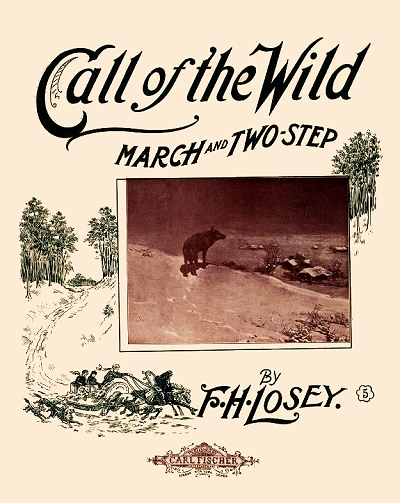 However, not only do the 1910, 1900 and 1880 census contradict this point, plus the lack of a WWI draft card, his very existence on record in the 1870 census strongly reinforces that his origin is different than what has been reported to date. He was born to George Trimmer Losey and Mary Jane Hoyt, the youngest of four siblings, including Ida Cornelia (1857), Cora Hewitt (1860), and Emaline "Emma" Frances (1863). George was a carpenter in Parma. According to the birth locations of their other children, they had already lived in Illinois and Pennsylvania by the time Frank was born. In the late 1870s the family relocated to Lawrenceville, Pennsylvania, just south of the border with New York, and around 60 miles due north of Williamsport, Pennsylvania. For the 1880 enumeration the family was shown in Lawrenceville with George listed as a carpenter and Cora as a school teacher.
However, not only do the 1910, 1900 and 1880 census contradict this point, plus the lack of a WWI draft card, his very existence on record in the 1870 census strongly reinforces that his origin is different than what has been reported to date. He was born to George Trimmer Losey and Mary Jane Hoyt, the youngest of four siblings, including Ida Cornelia (1857), Cora Hewitt (1860), and Emaline "Emma" Frances (1863). George was a carpenter in Parma. According to the birth locations of their other children, they had already lived in Illinois and Pennsylvania by the time Frank was born. In the late 1870s the family relocated to Lawrenceville, Pennsylvania, just south of the border with New York, and around 60 miles due north of Williamsport, Pennsylvania. For the 1880 enumeration the family was shown in Lawrenceville with George listed as a carpenter and Cora as a school teacher.
 However, not only do the 1910, 1900 and 1880 census contradict this point, plus the lack of a WWI draft card, his very existence on record in the 1870 census strongly reinforces that his origin is different than what has been reported to date. He was born to George Trimmer Losey and Mary Jane Hoyt, the youngest of four siblings, including Ida Cornelia (1857), Cora Hewitt (1860), and Emaline "Emma" Frances (1863). George was a carpenter in Parma. According to the birth locations of their other children, they had already lived in Illinois and Pennsylvania by the time Frank was born. In the late 1870s the family relocated to Lawrenceville, Pennsylvania, just south of the border with New York, and around 60 miles due north of Williamsport, Pennsylvania. For the 1880 enumeration the family was shown in Lawrenceville with George listed as a carpenter and Cora as a school teacher.
However, not only do the 1910, 1900 and 1880 census contradict this point, plus the lack of a WWI draft card, his very existence on record in the 1870 census strongly reinforces that his origin is different than what has been reported to date. He was born to George Trimmer Losey and Mary Jane Hoyt, the youngest of four siblings, including Ida Cornelia (1857), Cora Hewitt (1860), and Emaline "Emma" Frances (1863). George was a carpenter in Parma. According to the birth locations of their other children, they had already lived in Illinois and Pennsylvania by the time Frank was born. In the late 1870s the family relocated to Lawrenceville, Pennsylvania, just south of the border with New York, and around 60 miles due north of Williamsport, Pennsylvania. For the 1880 enumeration the family was shown in Lawrenceville with George listed as a carpenter and Cora as a school teacher.By this time, Frank showed some interest in the music, as well as an inherent talent. His musical mother became his first teacher, and helped guide him through his training with other teachers as well. By age 15, he was engaged in studies in the piano, violin, cornet and other brass instruments. Within a couple of years it was clear that his propensity was towards band music. Following his training in brass to a higher level, Frank obtained a degree and became the head of the brass department of the Mansfield Conservatory of Music in Pennsylvania. During his tenure there he taught brass and music in general and conducted the school's bands, as well as a local concert band in Hanover.
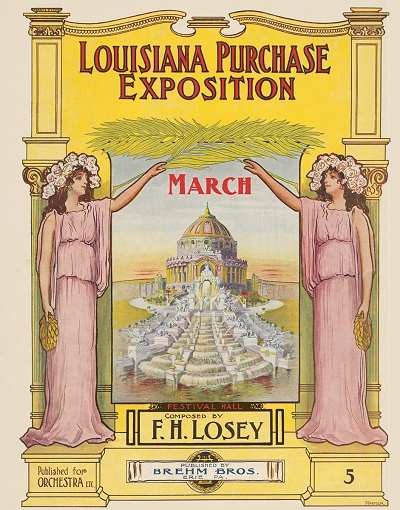 Somewhere during this time Frank became part of a mystery that is still unclear. According to an article in a July, 1892 newspaper in northern Pennsylvania, the following event transpired, raising a few eyebrows:
Somewhere during this time Frank became part of a mystery that is still unclear. According to an article in a July, 1892 newspaper in northern Pennsylvania, the following event transpired, raising a few eyebrows:A mysterious couple claiming to hail from Rochester, who were married by Justice Williams in Elmira on the night of June 30th, stipulating that the wedding should not be registered under two weeks, it is now stated were Frank H. Losey, a son of Hon. Geo. T. Losey, of Lawrenceville, and Miss Addie Moore, of Mansfield. Both were absent at the time, and various other circumstances corroborate the fact as stated. They are young people of excellent standing and connections, and their reasons for taking this clandestine method of uniting their fortunes are incomprehensible to their numerous friends.
Other demographics also concur that Frank married Adeline (Addah) Augusta Moore in June of 1892. There is a chance that she was pregnant at that time, thus the secrecy. A few years later, he released a march named Gloria which was dedicated to the (hard to confirm) late Gloria Losey. This may have been a daughter of the Loseys who died as a toddler. Local records did not confirm this possibility, so whoever Gloria was remains a bit of a mystery. What is not a mystery is that both Gloria, published in Cincinnati, and Colonel Quay's March, the latter dedicated to Colonel Matthew Stanley Quay and published in Philadelphia a year after his first march Snap Shot, quickly became brass band standards throughout the Northeast. Losey's fame began to spread as he released more marches, most arranged for band but a few for piano, and even an early cakewalk while they were still in vogue, Wandering Willie.
In 1898, when Gloria was composed, Frank was shown as a music teacher in York, Pennsylvania, living at 211 Frederick. In 1899 he was the bandmaster of a group in Bloomsburg in nearby Columbia County.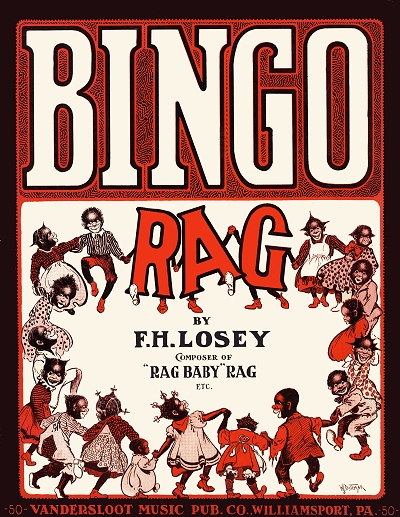 By the time of the 1900 enumeration he was working as a musician and composer in Corry, near Erie, Pennsylvania, an area where he would remain for many years with his wife Addah. As far as performance was concerned, Frank had to back down from cornet playing as he started experiencing a partial paralysis of his upper lip. For most of the rest of his career he would stick to the trombone and euphonium, less demanding on the lips. As an active member of the Fraternity of Freemasons, Frank wrote a number of marches dedicated to the organization or a particular lodge, many of them played by various lodge bands. Those titles that have Knights in them were invariably included in this legacy.
By the time of the 1900 enumeration he was working as a musician and composer in Corry, near Erie, Pennsylvania, an area where he would remain for many years with his wife Addah. As far as performance was concerned, Frank had to back down from cornet playing as he started experiencing a partial paralysis of his upper lip. For most of the rest of his career he would stick to the trombone and euphonium, less demanding on the lips. As an active member of the Fraternity of Freemasons, Frank wrote a number of marches dedicated to the organization or a particular lodge, many of them played by various lodge bands. Those titles that have Knights in them were invariably included in this legacy.
 By the time of the 1900 enumeration he was working as a musician and composer in Corry, near Erie, Pennsylvania, an area where he would remain for many years with his wife Addah. As far as performance was concerned, Frank had to back down from cornet playing as he started experiencing a partial paralysis of his upper lip. For most of the rest of his career he would stick to the trombone and euphonium, less demanding on the lips. As an active member of the Fraternity of Freemasons, Frank wrote a number of marches dedicated to the organization or a particular lodge, many of them played by various lodge bands. Those titles that have Knights in them were invariably included in this legacy.
By the time of the 1900 enumeration he was working as a musician and composer in Corry, near Erie, Pennsylvania, an area where he would remain for many years with his wife Addah. As far as performance was concerned, Frank had to back down from cornet playing as he started experiencing a partial paralysis of his upper lip. For most of the rest of his career he would stick to the trombone and euphonium, less demanding on the lips. As an active member of the Fraternity of Freemasons, Frank wrote a number of marches dedicated to the organization or a particular lodge, many of them played by various lodge bands. Those titles that have Knights in them were invariably included in this legacy.After submitting his work to a number of publishers, Losey finally got a regular ad hoc position with the Carl Fischer house in New York. For the next several years he would turn in scores to them for both piano and concert band while maintaining his regular duties in Erie. However, some of his piano reductions or piano-only compositions and arrangements of other composer's works started appearing under the Vandersloot Music Publishing Company logo as early as 1905. It was around this same time that Frank consistently applied opus numbers to his published work, in most cases insisting that they be included in the header. While most of the piano pieces were standard semi-popular fare of the time, including intermezzos, gavottes, marches and waltzes, Losey showed some interest in ragtime music as well. His earliest work with Vandersloot was primarily of band arrangements for pieces by manager Harry J. Lincoln.
Having spent six years with Fischer, but also having been fully engaged by the Williamsport publisher who put out his work more often, Losey officially signed on as a staff composer, arranger and editor in chief with Vandersloot in late 1908 or early 1909, which was managed at that time by Lincoln. Still working from his home base in Erie, he submitted some of his best syncopated work while in that position, and arranged many other fine rags and songs for piano. Among his more popular Vandersloot works adorned with the famous two-color covers of Walter J. Dittmar were The Electric Wizard, Rag Baby, Bingo Rag and Jolly Jingles. Perhaps his most circulated rag was Tanglefoot, hosting a comic cover showing a ragged cat trying to extract itself from a piece of what is presumably the Tanglefoot brand of flypaper.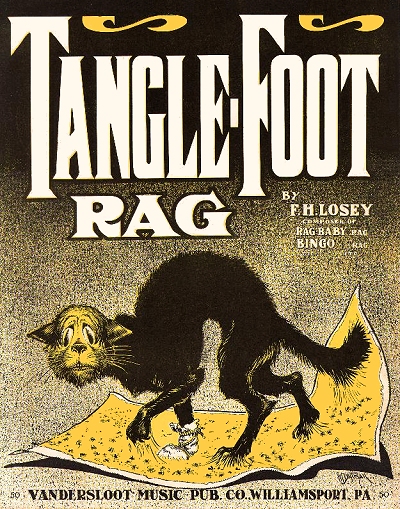 There were two large floods of copyrights issued to Losey in 1910, and again in 1912, that are a bit out of order from the year they were initially published, suggesting mass submissions to the Library of Congress copyright office. The 1910 census showed Frank and Addie living in Erie, with him as a composer and musician. This listing also presented another mystery, which concerns the 1920 enumeration.
There were two large floods of copyrights issued to Losey in 1910, and again in 1912, that are a bit out of order from the year they were initially published, suggesting mass submissions to the Library of Congress copyright office. The 1910 census showed Frank and Addie living in Erie, with him as a composer and musician. This listing also presented another mystery, which concerns the 1920 enumeration.
 There were two large floods of copyrights issued to Losey in 1910, and again in 1912, that are a bit out of order from the year they were initially published, suggesting mass submissions to the Library of Congress copyright office. The 1910 census showed Frank and Addie living in Erie, with him as a composer and musician. This listing also presented another mystery, which concerns the 1920 enumeration.
There were two large floods of copyrights issued to Losey in 1910, and again in 1912, that are a bit out of order from the year they were initially published, suggesting mass submissions to the Library of Congress copyright office. The 1910 census showed Frank and Addie living in Erie, with him as a composer and musician. This listing also presented another mystery, which concerns the 1920 enumeration.Enjoying the fruits of regular work with Vandersloot and leveraging his popularity, Frank formed Losey's Military Band School in 1914 in Erie. Not confining himself to just brass, he opened it to all instrumentalists, teaching both band and orchestra skills. By some accounts late in that decade, Losey's academy had given some training to nearly every musician in Erie and the immediate surrounding area. He maintained a loose but cordial relationship with the famed Repasz Band of Williamsport, and organization that often had some of the more classically-based Losey numbers in their repertoire, and some of whose members of the 1910s and 1920s came from Losey's institution as well. Both Frank and Addah were frequent visitors to the Williamsport area.
As of the 1920 census Frank and Addie were shown still living in Erie. However, two oddities exist here. Both of them have miraculously aged a mere three years over the past decade, showing as 43 and 39 years old respectively. To add to the confusion, there is now a daughter in the household,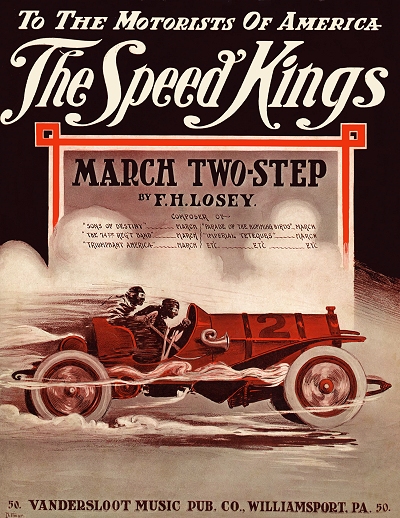 Ethel (Adaline), who was cited as being 15-years-old. This is at variance with the 1910 census where Adeline claims to have had no children, and in this one shows it as her own. Chances are that Ethel was an adopted daughter, but no definitive papers or birth record have been found to date. The Loseys also had a housekeeper to help out in their home. Ethel was married in Erie in 1924 to Carl A. Pinske, and the official record also cites Frank and Addah as her birth parents, but does not solve the prior mystery.
Ethel (Adaline), who was cited as being 15-years-old. This is at variance with the 1910 census where Adeline claims to have had no children, and in this one shows it as her own. Chances are that Ethel was an adopted daughter, but no definitive papers or birth record have been found to date. The Loseys also had a housekeeper to help out in their home. Ethel was married in Erie in 1924 to Carl A. Pinske, and the official record also cites Frank and Addah as her birth parents, but does not solve the prior mystery.
 Ethel (Adaline), who was cited as being 15-years-old. This is at variance with the 1910 census where Adeline claims to have had no children, and in this one shows it as her own. Chances are that Ethel was an adopted daughter, but no definitive papers or birth record have been found to date. The Loseys also had a housekeeper to help out in their home. Ethel was married in Erie in 1924 to Carl A. Pinske, and the official record also cites Frank and Addah as her birth parents, but does not solve the prior mystery.
Ethel (Adaline), who was cited as being 15-years-old. This is at variance with the 1910 census where Adeline claims to have had no children, and in this one shows it as her own. Chances are that Ethel was an adopted daughter, but no definitive papers or birth record have been found to date. The Loseys also had a housekeeper to help out in their home. Ethel was married in Erie in 1924 to Carl A. Pinske, and the official record also cites Frank and Addah as her birth parents, but does not solve the prior mystery.The 1920 census, which still showed Frank as a composer of music, also showed his new employer as Edison Records. In late 1919, Thomas Edison engaged Losey as a consultant for his Diamond Disc project, depending on his knowledge and experience to create some of the best concert band records in the industry. Edison was competing against the Sousa Band to some extent, and both Prince's Band and the Victor Records house band, using a format that was incompatible with all but his own phonographs. So he likely thought that having Losey would give him an edge. Frank arranged and conducted many sides for Edison's company over a period of close to nine years in two separate tenures. In this capacity he was brought to the attention of Edison's friend and greatest supporter, Henry Ford. The famed automobile manufacturer who was working on a number of Americana projects in the mid-1920s asked Frank to also arrange works for some legacy recordings by Ford's own orchestra in Detroit. The Edison and Ford recordings constitute some of the finest sonic examples of concert bands in the 1920s, deftly displaying Losey's arranging prowess. Losey also managed the music broadcasting portion of Edison's enterprise in the mid-1920s, and spent quite a bit of time lodging in Orange, New Jersey, while maintaining his Erie home.
Some time in the late 1920s Frank quickly phased out all his endeavors as he was becoming ill, and some data suggests the Loseys might have gone to Europe during that period. In the 1930 census, Frank and Addah were living in the same home as in 1920, now listed at 59 and 56 respectively, more or less matching their actual ages. Mr. Losey was still listed as a composer of music. Frank Losey finally succumbed to an unspecified illness in 1931 at age 61 and was buried in Erie. Starting in the late 1930s, records show that Addah Losey was renewing his copyrights on a regular basis, likely a source of her income well into the 1940s. She passed on in 1966 in Erie. Many of the works which Losey composed or had a hand in are still played by ragtime pianists and concert bands, a clear testament to his musical legacy.

 Compositions
Compositions